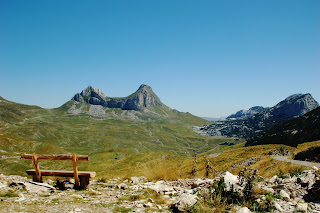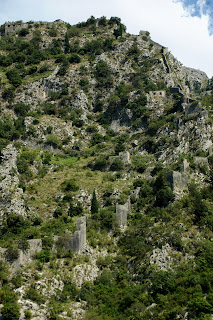DAY 13, PART 1/4: Montenegro
Romania-Bulgaria-Greece-Macedonia-Albania-Montenegro with Aventura Maramures
Il. 1 Sveti Stefan Island
The beach is about 100 m behind our camping gate. There is nothing better than a morning swimming in the warm sea, soon after a tasty breakfast. We install charged battery in the car, and go a head along the coast. The first stop is the Sveti Stefan (St. Stefan) island-hotel. One of the most picturesque and almost allways photographed place in Montenegro (il. 1)
Jakieś 100 m za bramą kempingu, na którym nocowaliśmy, znajduje się plaża. Nie ma nic lepszego niż kąpiel w ciepłym morzu o 7.30, niebawem po smakowitym śniadaniu. Osuszywszy się po wodnych igraszkach, odbieramy i instalujemy akumulator w samochodzie, po czym ruszamy wzdłuż wybrzeża. Pierwszy przystanek to Sveti Stefan (Święty Stefan) z hotelem-wyspą. Jedno z najbardziej malowniczych i najczęściej uwiecznianych na fotografiach miejsc Czarnogóry (il. 1)
Il. 2 Sveti Stefan agora presented by Marta
Il. 3 Medieval rock houses on Sveti Stefan Island

The first documented information about the island are from the early fifteenth century, when it defend itself against the onslaught of the Ottoman Turks. It probably has existed for over five centuries before this event, as a fishing village Petroviči, surrounded by ramparts. It was connected to the mainland by a causeway regularly flooded during tides and storms. After the victory, the causeway was expanded because of a decision to transform the island into a fortress with continuous access to the land. The new name of it was taken from a St. Stephen Orthodox Church built there in the middle of island. Two more, but less impressive churches, were built in similar period (all three have survived to this day). The island has also become a stop on the trade route between Venice and the Ottoman state. Over time, economic and security importance of the fortress was weakening, and residents began to wane. At the beginning of the twentieth century, with almost 400 inhabitants, their number dropped first to 150, and in the mid-twentieth century, only to 20. Soon after, the rest of the inhabitants were resettled on the mainland, transformin the island in a luxury hotel complex. All historic stone buildings (more or less 80) was renovated and island has regained former splendor. It was particularly popular in the 70s, hosting world stars and celebrities. To this day, it is the most exclusive and most expensive holiday complex in Montenegro. The cheapest accommodation in the hotel at the moment costs 600 euros.Entrance to the island, in the moments when it's not whole reserved, is also paid for visitors.
Pierwsze udokumentowane wzmianki na temat wyspy pochodzą z początków XV w. kiedy zdołała się obronić przed najazdem turków osmańskich. Przed tym zdażeniem istniała już ponoć od przeszło pięciu wieków jako wioska rybacka zwana Petroviči, otoczona murami obronnymi. Połączona była z lądem płytką groblą regularnie zalewaną podczas przypływów i sztormów. Po zwycięstwie, groblę rozbudowano, postanowiono bowiem przekształcić wyspę w twierdzę ze stałym dostępem z lądu, a świeżo wybudowana cerkiew p.w. św. Stefana dała jej nową nazwę. Z czasem zbudowano dwie następne, choć mniej okazałe cerkwie (wszystkie trzy zachowały się do dzisiaj). Wyspa stała się także przystankiem na szlaku handlowym między państwem osmańskim a Wenecją. Z czasem gospodarcze i obronne znaczenie twierdzy słabło, a mieszkańców zaczęło ubywać. Na początku XX wieku z prawie 400 mieszkańców ich liczba spadła najpierw do 150, a w połowie XX wieku zaledwie do 20. Niedługo potem przesiedlono resztę mieszkańców na ląd stały, przeszktałcając wyspę w luksusowy kompleks hotelowy. Odrestaurowano wszystkie zabytkowe, kamienne zabudowania (około 80-ciu) i przywrócono jej dawny blask. Szczególną popularnością cieszyła się ona w latach 70-tych, goszcząc światowe gwiazdy i celebrytów. Do dnia dzisiejszego jest to najbardziej ekskluzywny i najdroższy kompleks hotelowo-wypoczynkowy w Czarnogórze. Najtańszy nocleg w hotelu kosztuje w tej chwili 600 euro, a wstęp na wyspę, w chwilach gdy nie jest ona akurat w całości zarezerowana, także jest płatny dla zwiedzających.
Il. 4 Manicured lawns on the coast
Il. 5 Fortifications of Sveti Stefan Island fortress
Unfortunately we did not have enough luck to admire this beautiful medieval stone houses or winding, narrow streets closely. Apparently: Each building is a separate, unique and luxurious apartment. Houses do not have the numbers, but the romantic names like: "Under the orange flower", under the sea starfish" (source:
www.washandgo.wordpress.com). We hadn't a chance to check it out, however, if you have a lot of money, which you do not know how to squander, we advise you to make advance booking at the hotel on the island of St. Stefan, go to the local casino (the island is also sometimes called: Monaco of Adriatic) and leave an extra 50 euros for access to the private beach, situated on the mainland, close to the causeway. The cost is not small, but for sure, you will not certainly complain about the crowds of sunbathers.
As we already know there is no guarantee that you will be able to get to the island after coming to Sveti Stefan, but even if not, we think it worth a visit. Even only to see the complex from the mainland and take a few compromising photos on it background (il. 6-7).
My niestety nie mieliśmy dość szczęścia aby podziwiać z bliska te piękne średniowieczne domy z kamienia ani kręte, wąskie uliczki. Ponoć: Każdy budynek jest oddzielnym, niepowtarzalnym i luksusowym apartamentem. Domy nie mają numerów, lecz romantyczne nazwy „Pod kwiatem pomarańczy”, Pod rozgwiazdą morską”. Nam jednak, nie było dane sprawdzić tego osobiście. Jeśli jednak macie dużo pieniędzy, które nie wiecie jak roztrwonić, polecamy zrobić wcześniejszą rezerwację w hotelu na wyspie św. Stefana, udać się do tamtejszego kasyna (wyspa jest zwana czasem także, Adriatyckim Monakiem) oraz zostawić dodatkowe 50 euro, za wstęp na prywatną plażę, usytuowaną tuż przy grobli na lądzie stałym z widokiem na wyspę. Koszt nie jest mały, ale ci co się zdecydują z pewnością nie będą narzekać na tłumy plażowiczów.
Jak już wiemy nikt nam nie zagwarantuje, że przyjeżdżając do Sveti Stefan będziemy mogli się dostać na wyspę, ale nawet jeśli nie, to i tak uważamy, że warto przyjechać, żeby obejrzeć kompleks choćby z lądu i zrobić sobie kilka kompromitujących zdjęć na jego tle (il. 6-7)
Il. 6-7 Compromising photos of the island in the background












































